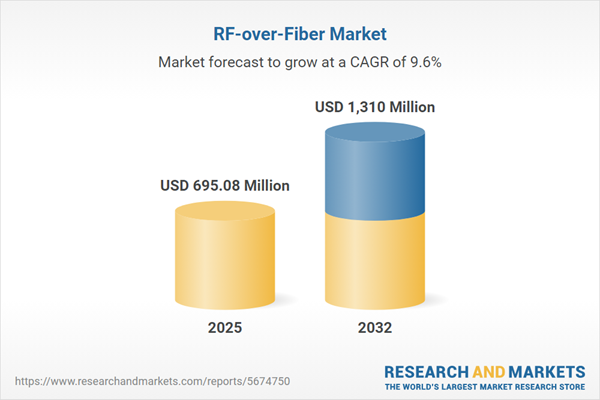Speak directly to the analyst to clarify any post sales queries you may have.
The RF-over-Fiber market is undergoing a period of significant transformation, driven by demand for next-generation connectivity solutions across telecommunications, defense, and media sectors. Enhanced by advanced optical technologies, RF-over-Fiber enables long-distance, high-fidelity transmission of radio frequencies essential for evolving global infrastructure.
Market Snapshot: RF-over-Fiber Market Size and Growth Dynamics
The RF-over-Fiber market grew from USD 634.86 million in 2024 to USD 695.08 million in 2025. The market is projected to continue its upward trajectory with a CAGR of 9.55%, reaching USD 1.31 billion by 2032. This sustained growth reflects accelerating investment in fiber-based RF transport, spurred by factors such as the rollout of 5G, rising global data consumption, and strategic upgrades of communication infrastructures.
Scope & Segmentation: Broad Spectrum of Applications, Components, and Technologies
- Applications: Cable TV Distribution, Military Communications, Satellite Communications (GEO, LEO, MEO), Test and Measurement, 4G Fronthaul, 5G Fronthaul
- Components: Fiber Optical Cables, Optical Amplifiers (Erbium Doped Fiber Amplifier, Raman Amplifier), Optical Detectors, Optical Modulators
- Technology Types: Analog RF-over-Fiber (External Modulation, Intensity Modulated Direct Detection), Digital RF-over-Fiber (DWDM, OFDM)
- End Users: Broadcast & Media, Defense (Electronic Warfare, Radar Systems), Healthcare (Medical Imaging, Remote Patient Monitoring), Oil & Gas (Exploration, Refining), Telecom Operators
- Topologies: Point to Multipoint, Point to Point
- Link Types: Bidirectional, Unidirectional
- Regions: Americas (North America, Latin America), Europe, Middle East & Africa, Asia-Pacific
- Key Companies: TE Connectivity Ltd, HUBER+SUHNER AG, OFS Fitel LLC, Viavi Solutions Inc, Corning Incorporated, Sumitomo Electric Industries Ltd, CommScope Holding Company Inc, Amphenol Corporation, II-VI Incorporated, Emcore Corporation
Key Takeaways: Strategic Insights for Decision Makers
- Strategic adoption of RF-over-Fiber is increasing across military, satellite, and broadcast networks to address requirements for security, reach, and signal quality.
- Integration of analog and digital technologies supports a broad range of deployment needs, improving network flexibility and spectral efficiency in both established and emerging markets.
- Ongoing digitalization and the move to centralized radio access are reshaping network topologies, enabling more effective maintenance and faster updating of wireless standards.
- Regional manufacturing and nearshoring are emerging as important tactics for mitigating supply chain disruptions and cost pressures in the face of changing tariff regimes.
- Collaboration between technology vendors and end users is accelerating innovation, producing tailored solutions for unique sector demands in healthcare, oil and gas, and defense.
- Choice of topology and link type enables operators to build customized solutions to balance redundancy, cost, and performance in complex deployments.
Tariff Impact: Navigating New Regulatory Challenges
The introduction of United States tariffs in 2025 brings notable uncertainty to the RF-over-Fiber supply chain and cost structure. Stakeholders are recalibrating procurement by evaluating nearshoring, domestic alliances, and design changes to manage tariff implications. These strategic adaptations will influence supplier relationships, project timing, and network development across multiple industry verticals.
Methodology & Data Sources
This report integrates qualitative expertise and quantitative data. Secondary research included technical publications and regulatory documents, complemented with primary interviews of industry executives and subject matter experts. Key data was validated using bottom-up market sizing, shipment tracking, and iterative expert consultations to ensure precise, actionable intelligence.
Why This Report Matters: Enabling Confident Strategic Planning
- Facilitates informed investment by mapping opportunity areas across verticals, regions, and technology types relevant to RF-over-Fiber.
- Delivers competitive insight into supply chain shifts and partnership strategies amid evolving tariff and regulatory requirements.
- Equips decision-makers to align technology roadmaps with sector-specific connectivity demands, increasing operational resilience and market reach.
Conclusion
RF-over-Fiber is positioned as a cornerstone for future-ready connectivity and resilient infrastructure. This report provides practical guidance and deep market visibility for leaders seeking to optimize commercial and operational outcomes as the industry evolves.
Additional Product Information:
- Purchase of this report includes 1 year online access with quarterly updates.
- This report can be updated on request. Please contact our Customer Experience team using the Ask a Question widget on our website.
Table of Contents
3. Executive Summary
4. Market Overview
7. Cumulative Impact of Artificial Intelligence 2025
Companies Mentioned
The companies profiled in this RF-over-Fiber market report include:- TE Connectivity Ltd
- HUBER+SUHNER AG
- OFS Fitel, LLC
- Viavi Solutions Inc
- Corning Incorporated
- Sumitomo Electric Industries, Ltd
- CommScope Holding Company, Inc
- Amphenol Corporation
- II-VI Incorporated
- Emcore Corporation
Table Information
| Report Attribute | Details |
|---|---|
| No. of Pages | 184 |
| Published | October 2025 |
| Forecast Period | 2025 - 2032 |
| Estimated Market Value ( USD | $ 695.08 Million |
| Forecasted Market Value ( USD | $ 1310 Million |
| Compound Annual Growth Rate | 9.5% |
| Regions Covered | Global |
| No. of Companies Mentioned | 11 |









